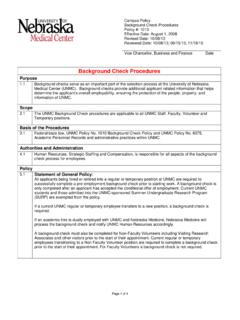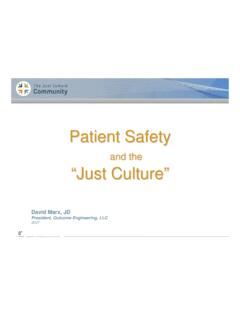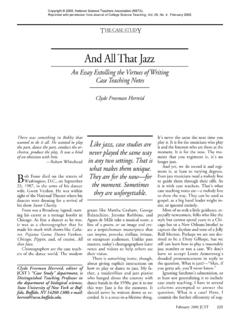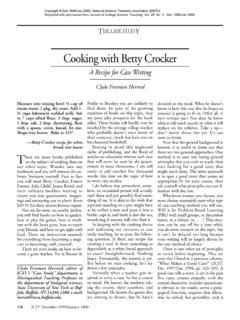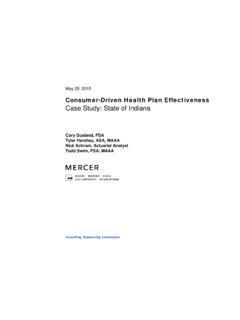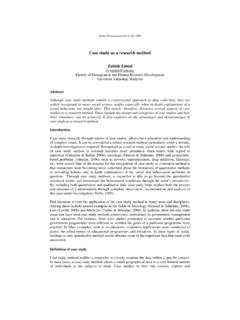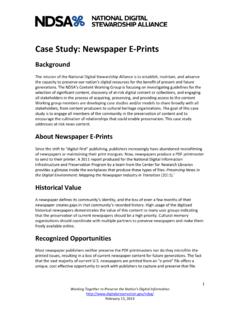Transcription of Case Study: Choosing a Fall Risk Assessment
1 case study : Choosing a fall Risk AssessmentCase study : XYZ Hospital At Baseline Did not have a team accountable for fall risk reduction throughout the facility Clinical judgment used to assess fall risk Newly formed interprofessional fall risk reduction team Sense of urgency to choose fall risk Assessment tool for integration into EMR Used work sheet created by CAPTURE Falls project to calculate measures of predictive validity for 3 different fall risk Assessment tools using their own patient dataCase study .
2 XYZ Hospital Reviewed records from 2011 and 2012 26 patients fell 37 patients did not fall Determined Scores for 3 tools using 2 cut points for each tool John Hopkins fall Risk Assessment Tool1,2 Morse Falls Scale3-5 fall Risk Assessment Scoring System (FRASS)6,7 Test Performance Measure Work SheetSee worksheet that walks you through the steps of determining sensitivity, specificity, and predictive values of a tool using data from your settingRequires understanding of a 2 x 2 table 2 x 2 table combines results of two outcomes Rows contain the results of your Assessment Columns contain the outcome of interest ( fall vsno fall ) Assessment ResultsDid the patient fall ?
3 FallNo FallTotal+ Resulta (true +)b (false +)a + b-Result c (false -)d (true -)c + da + cb + dGrand TotalColumn total = # of ptswho fellColumn total = # of ptswho DID NOT fallRow total = # of ptswith + test resultRow total = # of ptswith -test resultSensitivity = a/a+cSpecificity = d/d+bPositive Predictive Value (PV+) = a/a+bNegative Predictive Value (PV -) = d/c+dGeneral Format of 2 x 2 TableMeasures of Predictive ValiditySensitivity is the test s ability to obtain a positive test when the target condition is really present, or the true positive rate, and it tells the clinician how good the test is at correctly identifying patients with condition of interest (iewill fall ).
4 Specificity is the test s ability to obtain a negative test when the condition is really absent, or the true negative rate, and it tells the clinician how good the test is at correctly identifying the absence of a condition (iewill not fall ).Measures of Predictive ValiditySensitivity and specificity have limitations due to false positives and false negatives. Choosing the highest values for positive and negative predictive value minimizes false positive and false negative findings. Measures of Predictive ValidityPositive predictive value is the probability that a person who tests positive actually has the condition of interest (they fell).
5 Negative predictive value is the probability that a person who tests negative does not have the condition of interest (they did not fall ). FRASS Cutpointat 8+ High Risk For FallsAssessment ResultsDid the patient fall ?FallNo FallTotal+ Result(FRASS >8)a = 26(true +)b = 28(false +)54-Result (FRASS < 8)c = 0(false -)d = 9(true -)9263763 Sensitivity a/a+c26/26 = 100% of fallers had + test (>8)Specificity d/d+b9/37 = 24% of nonfallershad test (< 8)PV+ a/a+b26/54 = 48% of those with + test (>8)fellPV-d/c+d9/9 = 100% of those with test (< 8) did not fallFRASS Cutpointat 15+ High Risk For FallsAssessment ResultsDid the patient fall ?
6 FallNo FallTotal+ Result(FRASS >15)a = 17(true +)b = 8(false +)25-Result (FRASS < 15)c = 9(false -)d = 29(true -)38263763 Sensitivity a/a+c17/26 = 65% of fallers had + test (>15)Specificity d/d+b29/37 = 78% of nonfallershad test (< 15)PV+ a/a+b17/25 = 68% of those with + test (>15)fellPV-d/c+d9/38 = 76% of those with test (< 15) did not fallComparing ResultsTool (Cut Point)SensitivitySpecificity+ Predictive Value-Predictive ValueJohns Hopkins (6+)100%0%41%0%Johns Hopkins (13+)89%41%51%83%Morse (45+)100%24%48%100%Morse (75+)50%70%54%67%FRASS (8+)100%24%48%100%*FRASS (15+)65%78%68%**76%*100% of those who tested negative DID NOT fall **68% of those who tested positive DID fallCase study SummaryXYZ Hospital plans to use FRASS as their fall risk Assessment toolIdentify those patients with a score of 8 14 as high risk for falls: if score < 8, patient probably will not fall (Of the 9 with a score < 8, none fell).
7 Identify those patients with a score of 15+ as at very high/severe risk for falls; if score 15+, patient will likely fall if interventions are inadequate; of those patients who scored 15+, 68% actually SS, CvachM, Dawson PB, et al. The Johns Hopkins fall Risk Assessment Tool: postimplementationevaluation. J NursCare Qual. 2007;22(4):293-8. Hopkins tool is copyrighted. Contact: Stephanie S. Poe, JM, Black C, OberleK, et al. A prospective study to identify the fall -prone patient. Social Sciences & ;28:81 , De GeestS, MilisenEvaluation of the Morse fall Scale in hospitalisedpatients.
8 Age Aging. 2006:35(3):311-313. fall Scale is freely available at Victorian Quality Council. Minimisingthe risk of falls & fall -related injuries: Guidelines for acute, sub-acute and residential care settings. Available at: Lee Hughes for permission to use the FRASS, email content in this document was originally shared as part of a CAPTURE Falls Collaborative Support Call on January 22, 2013.

